For years, companies had a huge demand for backend developers as it was important to run a seamless website. Frontend developers were not respected much. Later, as more and more companies came into existence, the demand for frontend developers saw exponential growth in demand as companies want to stay ahead and attract more and more visitors. Now, with the introduction of JavaScript frameworks, higher security demands, lack of a reliable workforce, and increasing complexities both in backend and frontend panels, companies are looking for professionals who can handle both aspects of websites. In other words, they are now looking for full stack web developers.
Expectations from a Full Stack Web Developer
A full-stack web developer is expected to understand: This is just a comprehensive list of all the possible tasks that you may need to do as a full-stack web developer. When working for a company, you are not expected to carry out all the tasks all by yourself as the company needs to meet the deadlines, so tasks are always divided. In such cases, your full-stack knowledge will help you better collaborate with your colleagues. When working as a freelancer, you’ve got an upper hand. As a freelance full-stack web developer, you can ask for higher wages. Also, you may be expected to do most of the above-mentioned work all by yourself. Sometimes, even as a freelancer, you may need to work in a team, so you won’t need to handle much of the tasks alone. Freelancing clients are reluctant to try newbies with no working history unless their bid is comparatively low and the client is also low on budget. So, your higher bid can be readily accepted by your clients.
Salary of a Full Stack Web Developer
Average salary (if you work in a company): $104k (US-based) Average hourly rate (if you work as a freelancer): $70-$150+ As a freelancer, your rate depends on various factors:
Detailed Explanation of Full Stack Technologies
People who are new to this field have a lot of confusion regarding the type of technology they should work with. Here is a detailed explanation of all the possible aspects that you need to understand. This includes the above-mentioned 17 points.
1. Frontend
You must know HTML5, CSS3 (LESS, SASS), jQuery, JavaScript(JS) Framework. React JS, Backbone JS, and Angular JS are the most used JS Frameworks.
2. Backend
You must be strong in any of these programming languages - Ruby, Python, PHP, or Node JS. Some other languages include GO, Scala, R, C#, etc. You should also be good at handling application logic, user authentication, data operations, and MVC (Model-View-Controller). You must also have hands-on experience with at least one of these backend frameworks - Express, Rails, Django, Laravel, or Spring. You must understand CRUD operations i.e. Create, Rewrite, Update, and Delete. This applies to database operations.
3. Database
You should know database handling techniques, query optimization, data encryption methods and much more depending on the type of database used. MongoDB is the most popular database. MySql, Oracle, SQLServer, and Redis are also widely used.
4. Servers
You must have a working knowledge of Apache or Nginx server. Many companies prefer serverless platforms such as AWS, Google Cloud Platform, and so on.
5. DevOps
You must understand agile operations as well as automation to maintain a continuous delivery of products and services in a short time and reliable manner. DevOps is short for Development and Operations. It is a combination of software development and IT(Information Technology) operations.
6. Hybrid Apps
You can choose between the web and mobile development. If you want to be a full-stack mobile app developer, you must understand the technologies used for hybrid apps. Hybrid apps can run anywhere irrespective of the platform. Apps make use of similar frontend and backend technologies as websites. Some popular mobile app frameworks are React Native, PhoneGap, Xamarin, Flutter, Ionic, and Framework 7.
7. Version Control
You should know how to handle document modifications through any of these VCS(Version Control System)- GIT, Grunt, Subversion, etc.
8. Security measures
You must be aware of security threats that relate to front-end, backend, and database such as malware attack, injection issues, and so on.
9. APIs
You should know about the different types of request and response APIs. REST (Representational State Transfer) and SOAP (Simple Object Access Protocol) APIs are the most common.
10. UX Design
You are not really expected to have exquisite designing skills. But if you are aware of some UX design aspects, it can be a plus point especially as a self-employed professional. Since you may need to suggest some changes to the client for better usability. For this, study the UX principles and understand what makes a website more user-friendly.
11. Data Structures
You certainly need to understand the complexity of data irrespective of what type of developer you are. Structuring data can help you reduce system complexity. As a result, your code can provide faster processing and reliable information.
12. Testing
Testing is a plus point. You’ll need to write unit tests. Also, run the tests on your code with a full understanding of the automation process. This will help you build tests and deploy them on a large scale.
13. SEO
SEO (Search Engine Optimization) plays the most crucial part. Even some companies readily pay thousands of dollars to make their website rank higher. So, you can understand the importance of this field. SEO is comprised of SEO copywriting, Technical SEO, Mobile SEO, Local SEO, on-page SEO, and off-page SEO. You’ll need to understand the concept of Technical SEO. Technical SEO is about website speed, crawl-ability, security, site architecture, mobile-friendliness, and indexing. If you understand this part of a website, you can give a huge boost to your salary.
14. Stacks
Knowledge of at least one development stack is a must. This may be asked during your interview session, “Which stack do you fully understand?”. The most popular ones are LAMP (Linux, Apache, MySql, PHP), MEAN (MongoDB, Express, AngularJS, NodeJS), MERN (MongoDB, Express, ReactJS, NodeJS ), Ruby on Rails (Ruby, SQLite, PHP), and Django (Python, Django, MySql). All these stacks are comprised of a frontend language, backend language, framework, and database.
15. Technical Writing
Each developer is expected to document their code, which is then added to a system knowledge base. As a developer, writing doesn’t come naturally to us. So, practice writing some samples. Technical writing is a wide field. In this, you may be asked to do technical copywriting, which means detailing products and services to be sold to B2B or B2C customers. It also includes repair manuals, medical studies, press releases, catalogs, and so on. Technical writing is a plus when you work as self-employed. Working in a company, you can always get a helping hand to finish your documents.
16. Hardware and OS
You should very well understand system architecture. Most of the developer use Linux for development. Sometimes, you may need to use Windows when you are working on Windows-based frameworks especially .Net. Your friendliness with at least one of the popular OS(Operating System) is very important. Linux is highly recommended.
17. Project Management Tools
As a company employee, these tools will come handy to you with most of the work done by your project manager. As a self-employed(freelancer), you may need to work with any of these tools - Basecamp, Jira, Trello, Redmine, Teamwork, etc., and understand them all by yourself. Some other points can also be added depending on your project type.
Full Stack Web Development Courses
Now, online courses are so popular that you can find thousands of websites running tech courses for free as well as paid. You can even receive personal mentoring from sites like Code-mentor. Start with any website that you find reliable. Search “online courses for [Your Chosen Subject]” on Google (well, it’s the most popular search engine). While going through your resume, your interviewee is more interested in your projects rather than a learning platform. Make sure to implement what you’ve learned and developed your own small projects for your portfolio.
Types of Full Stack Web Development Projects
Developers who are new to this term are very curious to know the types of projects that come under this category. I figured this out through online forum sites. The most basic point that you need to cover in your projects is to show a flow of data from the frontend to the backend to the database and from the database to the backend to the frontend. Some types are:
Social network for local groups Online forum sites User account creation- sign in and sign out Membership sites Room and Cab booking websites and apps
And so on Any website/app that requires user input and retrieval of user information from database count as full-stack web development. This is just a comprehensive list of all possible aspects of full-stack web development. You don’t need to become a master of all especially when you work for a company. As a company employee, it is important to excel in any of the programming stacks mentioned above. If you work as a freelancer, you can practice as much as you want and ask for a higher rate. © 2020 Prachi-Sharma



